In the above video I discuss backsaws, and what to look for when you’re buying a back saw. I focus on comparing two of the most popular mid-priced dovetail saws, the Veritas dovetail saw (by Lee Valley) and the Lie-Nielsen dovetail saw.
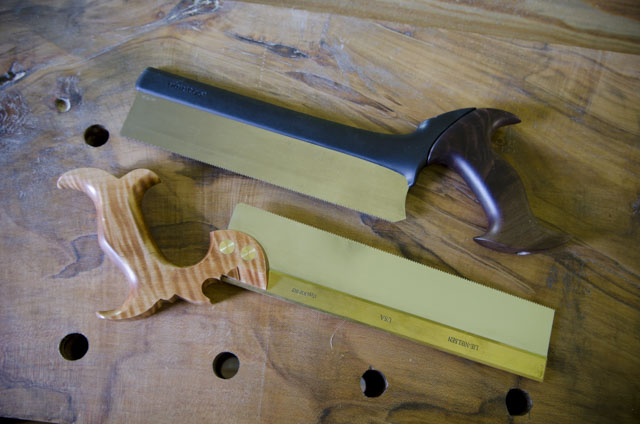
What is a Back Saw?
A back saw is a hand saw that has a stiff metal back (brass, steel, or plastic) that rigidly holds a thin saw plate for use in cutting accurate furniture joints. You can learn all about different types of back saws (e.g. dovetail saws, carcass saws, tenon saws, etc.) in my hand saw buyer’s guide (here).
Which New Dovetail Saw is Best?
A dovetail saw is the most commonly purchased backsaw, since it is used so much in cutting dovetail joints. It has a rip tooth configuration (again, discussed in my hand saw buyer’s guide), which enables it to cut with the grain, but also works acceptably well at cutting across the grain on small cuts. For this reason, a dovetail saw can get you by for awhile as your first backsaw.
The price of a new dovetail saws vary wildly, starting with a straight handled gent’s saw, which can usually be purchased for anywhere between $10 and $40.
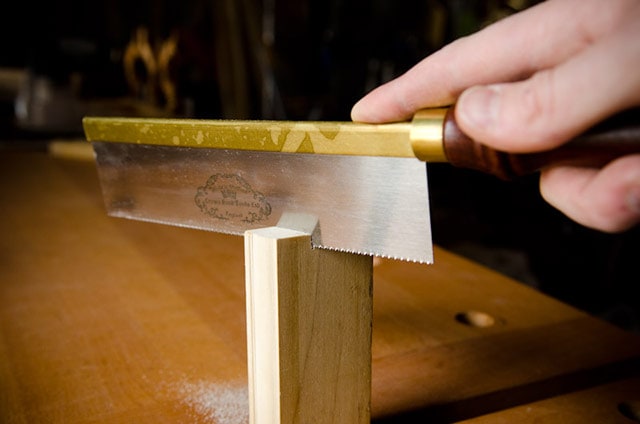
Not everyone loves a Gent’s saw. Students in my school seem to lean away from this type of saw because it’s a little more awkward to hold, but I have seen marvelous furniture makers use this type of hand saw. But Gent’s dovetail saws usually don’t come well sharpened, so you’ll need to learn about sharpening, or find someone who can sharpen one for you. I buy a lot of antique hand saws, so I don’t have a problem with sharpening saws like these. But this article focuses on choosing a dovetail saw that performs well right out of the box.
On the upper price range are dovetail saws with open or closed totes (handles) that have been made by smaller saw manufacturers (like Bad Axe, Adria, Rob Cossman, & Tools for Working Wood). They usually run in the $200-$300 range, which is a bit difficult for most woodworkers to afford. The best dovetail saw that you can acquire is one that you make yourself, because the handle is shaped especially for your hand, and you use quality saw parts that can be purchased for as low as $45 for a kit. Tom Calisto teaches a two day class in my school called “Make a Dovetail Saw with Tom Calisto” where students make a dovetail saw and a tenon saw, and they use the high-quality parts that Tom manufactures in his machine shop. Here’s a photo of a fine dovetail saw that a recent student, John Hawkinson, made in this class:
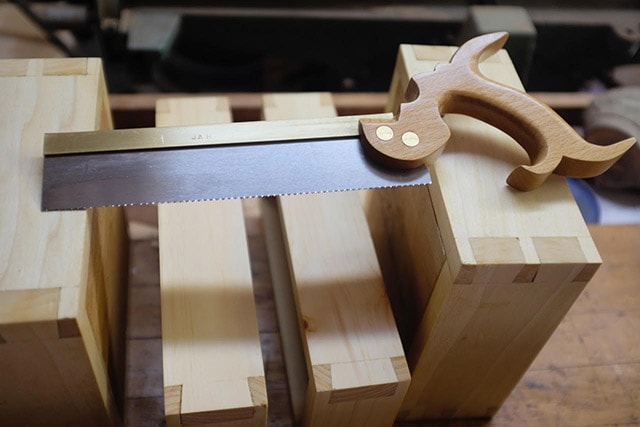
And here is a dovetail saw and tenon saw made by another recent student, Richard Kurshan:
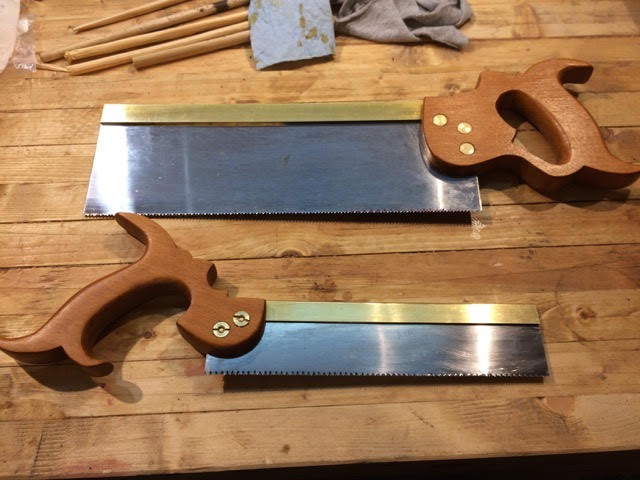
But a lot of woodworkers don’t live close enough to take a backsaw making class, and can’t rationalize spending $200-$300 on one dovetail saw, so they usually narrow their choice down to two moderately-priced dovetail saws: The Lie-Nielsen dovetail saw (made in Maine), and the Veritas dovetail saw (made in Canada). I’ve owned a couple Lie-Nielsen back saws saw for quite a few years, but recently purchased a few more for my school, along with four Veritas back saws. So I was excited to put them head-to-head in a dovetail saw comparison, looking at four categories: (1) Aesthetics / looks, (2) Comfort, (3) Performance, and (4) Price:
1. Aesthetics
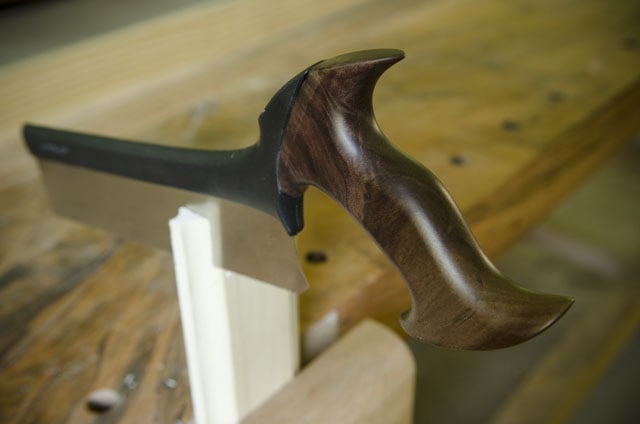
This is a rather superficial category, but it is important to some people. While both of the handles are made of lovely figured wood (Lie-Niesen uses figured maple, and Veritas uses a variety of nice wood…mine came in walnut), the Lie-Niesen saw overall has a more traditional 18th century look with an open-tote shaped handle, brass back & brass saw nuts, and now they offer a tapered saw plate (to aid in a better sawing angle). The Veritas saw (like their other tools) has an original, more modern design. It is also an open tote handle.
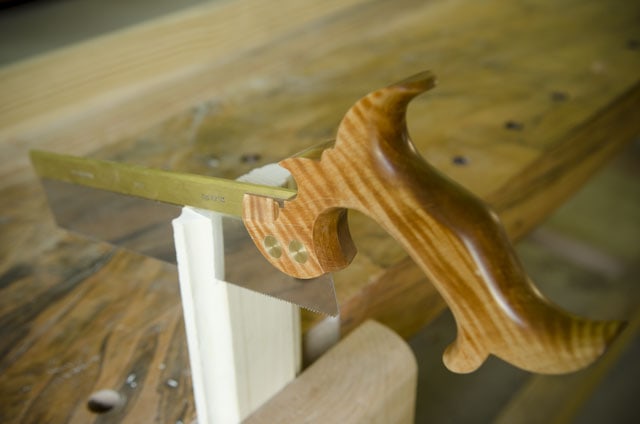
While I congratulate Lee Valley for their originality in tool design (rather than just mimicking old tool designs), I tend to prefer the more traditional-looking backsaws. The molded plastic saw back isn’t my favorite look. I’ve talked with a lot of other woodworkers who share this opinion-who prefer the brass back and traditional handle. But hey, looks aren’t everything! Right?
2. Comfort
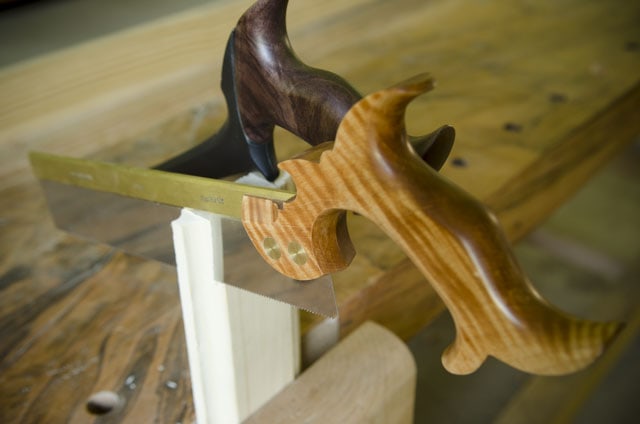
In my extensive testing, I found both the Veritas dovetail saw and Lie-Nielsen dovetail saw to be comfortable to use. The handles are nicely shaped. Unless you’ve tried out a dovetail saw that was custom-made for your hand, you’ll find both of these saw handles to be comfortable. They are more-or-less equally comfortable for the average hand.
3. Performance
In my opinion, performance is the most important consideration. I went into this test, figuring that I wouldn’t really see too much of a difference in performance, but I was a bit surprised to see a noticeable difference between the performance of these two dovetail saws. I compared brand new versions of both dovetail saws to make sure I wasn’t comparing a new Veritas saw with my old Lie-Nielsen saw (that has since been sharpened by me). I wanted to compare the performance/sharpness of each saw right out of the box.
I drew vertical lines down two boards, and proceeded to make saw cuts. Both dovetail saws tended to track well, or in other words, they didn’t drift off the line much (a couple times they did, but that was due to my lack of concentration). This means that both saws had evenly set (bent) teeth right out of the box.
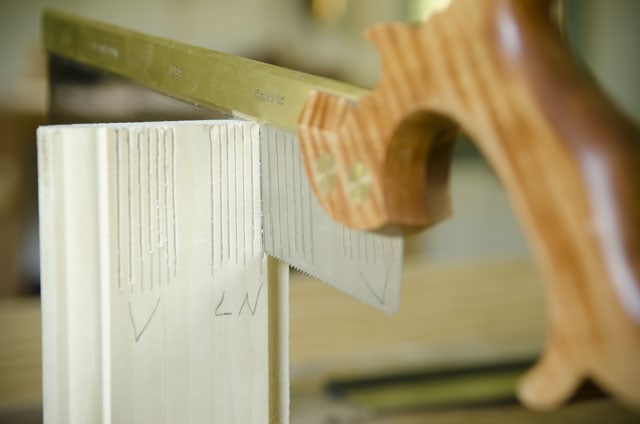
The more noticeable differences were (a) ease of starting the cut, (b) ease of sawing, and (c) quality & size of the saw kerf. The Lie-Nielsen dovetail saw started the cut quickly. I was able to easily push the saw forward to break the arris (fancy way of saying a sharp edge), with no need to take a back stroke to establish the kerf. The Veritas dovetail saw, on the other hand, wouldn’t break the arris with a forward stroke, so I had to use a back cut, then two, then three to get the saw to eventually cut moving forward.
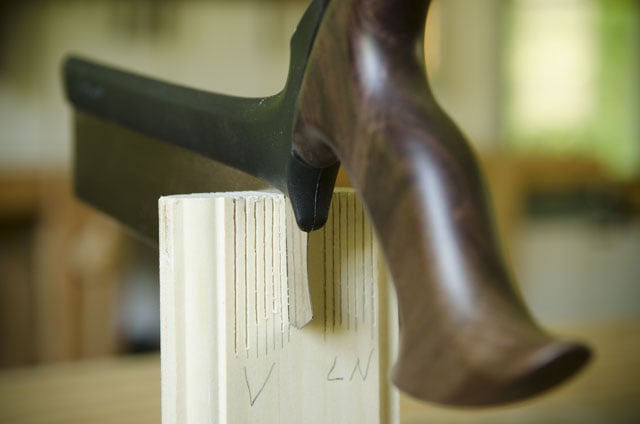
The Lie-Nielsen saw cut quickly and easily down the line, and left a very fine and thin kerf, which leads to more accurately fitting wood joints. The Veritas saw cut noticeably slower down the line, required more effort to get the saw to cut, and produced a screeching noise that is common with some saws that haven’t been sharpened properly. The last thing you want to do when cutting is to squeeze the saw handle to get it to cut. White knuckles (from squeezing too hard) are a no-no when using a backsaw. Squeezing the saw leads to drifting off the line. Because of this I found it ever so slightly harder to cut straight with the Veritas dovetail saw. The lines were still pretty straight, but the kerf was a bit larger and more ragged (as you can see in the photos above). But I’ve definitely seen much worse on some antique hand saws.
I concluded that the difference in performance was due to tooth size, saw plate thickness, and factory sharpening. The Veritas dovetail saw has a tooth count of 14 tpi (teeth per inch), and the Lie-Nielsen dovetail saw has a tooth count of 15 tpi. A recent student had a fine cut Veritas dovetail saw with 20 tpi, and it still appeared to have some performance issues. Plus, 20 tpi is more difficult to sharpen than 14-15 tpi, so I try to stay under 15 tpi.
Regarding saw plate thickness, per my digital caliper, the Lie-Nielsen dovetail saw plate is 0.015-inches thick:
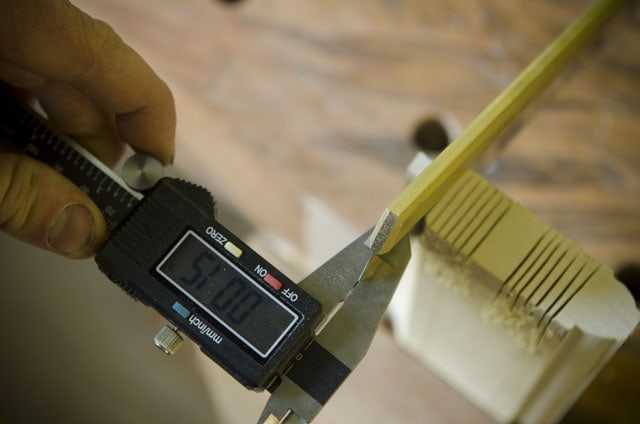
And the Veritas saw plate is about 0.020-inches thick. This doesn’t sound like a big difference, but it seemed to make a notable difference in performance. It’s possible that some of the difference in kerf size may be due to a different amount of set (bend) in the teeth, but they appeared to both have a minimal amount of set.
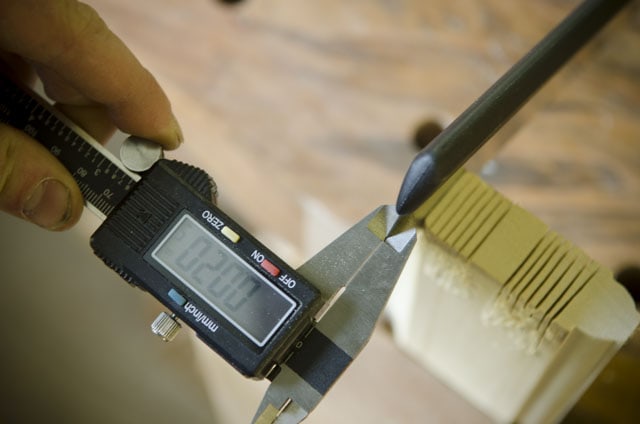
I tend to think that the saw plate thickness and difference in factory hand saw sharpening methods are the two biggest factors in the difference in performance. I haven’t yet tried to resharpen the new Veritas dovetail saw to see if the cutting difficulty could be remedied, but I’ll give that a try soon. You can relax the rake of the first inch of teeth to at least help with starting the saw more easily.
Keep in mind that the Veritas dovetail saw is by no means a poor performer. I just feel that the Lie-Nielsen saw is a bit better performer. I confirmed my findings in a class two days ago (“Make a Moravian Footstool with David Ray Pine“). The class focused heavily on cutting complex, angled dovetails in walnut. As I hovered around helping students, I was able to observe their opinions on the back saws, and had some of the students compare the performance of the two dovetail saws. The unanimous consensus was that the students preferred the performance of the Lie-Nielsen dovetail saw over the Veritas dovetail saw. This wasn’t a large sample size, but it did validate my opinion to some extent. And though it doesn’t have a custom-made handle to perfectly fit my hand, I found the Lie-Nielsen dovetail saws to cut just as good as my custom-made dovetail saws.
4. Price
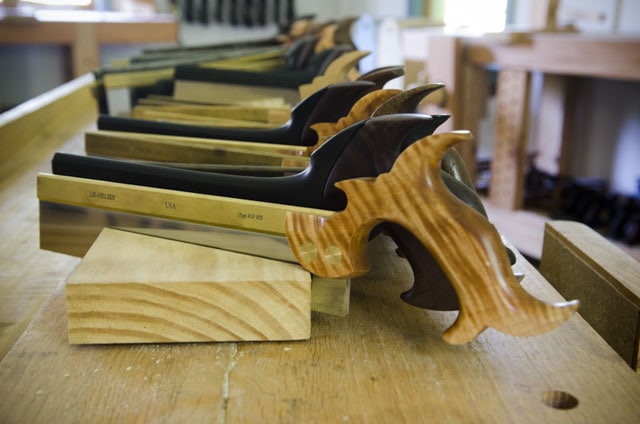
Up to this point, the Lie-Nielsen saw seems to be the clear winner. But when the last factor, price, enters the equation, the results can change. The Lie-Nielsen dovetail saw, while much cheaper than the dovetail saws made by the smaller saw companies, is still not cheap. It currently retails for $125 $150, plus shipping. You can buy it here at Highland Woodworking or here at the Lie-Nielsen website.
The Veritas dovetail saw is a much more affordable dovetail saw, retailing between $69 and $76, plus shipping. You can buy it here at Highland Woodworking or here at the Lee Valley website. You may be willing to overlook some of the small performance and aesthetic issues to save $50-$60. The price was certainly what enticed me to purchase some of these back saws.
And if you’re considering taking a class at my school, be sure to wait until you’ve registered for a class to buy any new tools from Lie-Nielsen and Lee Valley, because Lee Valley offers my students a 15% discount on their purchase, and Lie-Nielsen offers my students a 10% discount. You just have to give them proof of class enrollment.
So which dovetail saw should you buy? That’s a question that you’ll have to answer, but hopefully I’ve given you enough information to help you out. Please comment below and let me know what experiences you’ve gathered when buying backsaws!
***Update: Florip Toolworks in Michigan came out with a fairly affordable dovetail saw ($85). I did a review on these dovetail saws here. Update: They raised their price to $120.

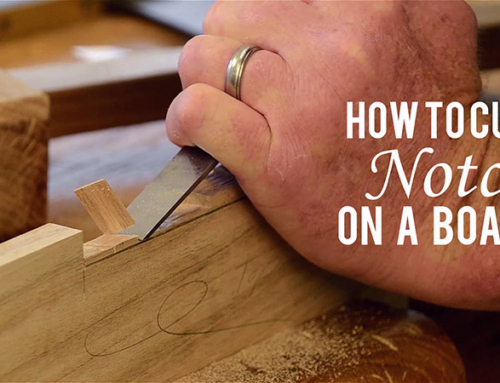

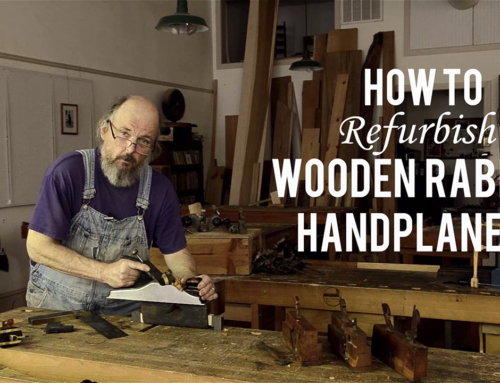
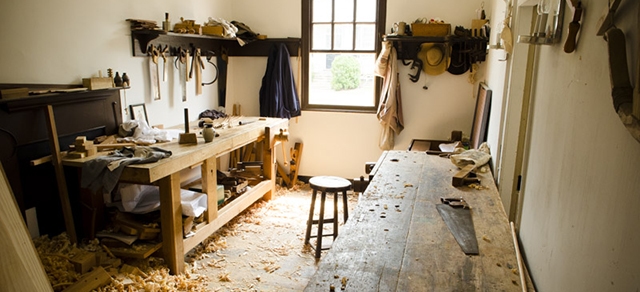
15% OFF? That makes the Veritas saws even cheaper. I was in the UK visiting a woodworking school there. The school has enough dovetail saws (I saw more than a dozen at least) for its students and all are Veritas. The school budget was a factor, I learned, but the head instructor said those saws are as good as any others they have screened in terms of functions and performance.
I have both and like both in their place. However, I like the weight of the brass back on the LN better in practice. Others like the lighter weight of the Veritas. They both work equally well and are both are well made. To each their own.
I have 3 of the best..Lie Nielson and 2 more..But prefer the Rob Cosman dovetail saw..just place it and cut..NO downward pressure at all. Thats my best bet.
Joshua
You forgot to add the Adria, Bad Axe, and the most expensive Rob Cosman’s.
Respectively, they’re great saws but, after all it’s no more than a piece of steel with teeth equiped with a handle!
Just added them, thanks for the reminder!
I had the opportunity to try the Veratas, LN and Rob Cosman saw during a class I was taking. Yes the Veratas and LN saws are more sexy, but, in the end there is no comparison on the ease and quality of cut. Spend the extra money and get a Cosman saw. If one is into furniture making, where one is tackling construction with expensive woods, the extra money spent here will save money and increase quality further on.
You might want to check out Florip Toolworks. They’re selling a 9″ traditional folded brass back dovetail saw for $85. I haven’t used one so I can’t say how they saw.
Thanks for the head’s up Rick!
Thanks for the information about discounts and the saw comparisons. Perhaps learning to make one is even better.
You’re most welcome Matt! We’d love to have you join us for a saw making class.
Should be rob cosman; but wait you didn’t test it….